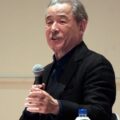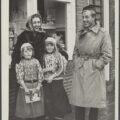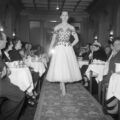Bonnie Cashin – Influential designers
October 14, 2017Bonnie Cashin was an American designer credited with bringing in easy to wear casual styles to the independent postwar woman. The clothes aren’t dramatic creations that turn heads but more understated, wearable chic – ”Women buy Cashin clothes because they are cozy and comfortable, not because they bowl people over,” as the fashion writer Bernadine Morris wrote in The New York Times in 1968.
Bonnie Cashin – Forgotten pioneer
She’s one of the designers dubbed “forgotten” – “the forgotten pioneer of clothes as we know them!” – but since many people know her name, just not as many as know the name of Chanel or Dior, I’d prefer to call her “under-appreciated”. It’s my experience that any designer who hasn’t recently had a loudly trumpeted retrospective at the Met Museum or lacks a perfume display at Debenhams is apparently forgotten by the world.
However, her introduction of light layers and loose, comfortable clothing as opposed to the structured and rigidly underclothed outfits of pre-war women was extensively copied and has a legacy in the way most women dress today and several of her designs for bags are still in use, albeit without credit.
During her lifetime Bonnie Cashin Designs were sold in top London and Paris department stores, and she designed for many other companies including Hermès, Ballantyne, Aquascutum and Coach, who still sell versions of her bucket and tote bag and feature the brass toggles and clasps she first introduced.
Bonnie Cashin – an award winning designer
Some Bonnie Cashin bag designs.
She won two Coty Awards, in 1950 and 1968, and was the first designer chosen to design paper patterns for home use by the New York Times in their monthly Patterns of the Times: American Designer series in the 1950s.
Bonnie Cashin was inducted into the Coty American Fashion Critics Hall of Fame in 1972 and in 1979, she established the Innovative Design Fund, which awarded up to $10,000 to a textile, furnishing or fashion designer.
History of the designer
Bonnie Cashin was born in 1908, and as a child moved around California quite often. Her mother Eunice Cashin, a dressmaker, wasted no time in opening a business in each new town. She taught her daughter all she knew. ”Before I could write I could sew,” Cashin explained in a 1973 interview, explaining that she was given scraps of fabric to play with as a tiny tot. Later on, her mother took a hand in Cashin’s business, sewing samples for her and having a 1% share. Mother and daughter lived in adjoining apartments and were very close right up to Eunice’s death. Bonnie’s father was named Carl Cashin and was a photographer and an inventor.
Bonnie Cashin did not start her own label until 1951, at the age of 43. But she was hardly a late bloomer. In the meantime, having graduated from Hollywood High School and the Art Students League she initially joined a Los Angeles ballet company as its designer, then whilst still under 20 moved on to design costumes for theatre at a furious pace. She later credited this experience in designing clothes that needed a lot of practicality and room for movement as her core inspiration for the clothes she then designed for women in every day life.
Bonnie Cashin – A patriotic designer
As world war two hit America, she became involved in designing uniforms for the female troops. When it ended she came back to costumes, designing for 20th Century Fox. Bonnie Cashin designed for over 60 films, including “A Tree Grows in Brooklyn,” “Laura” and “Anna and the King of Siam.”
Her first sportswear collection was designed in 1949, for the Adler firm. “Sportswear” didn’t mean then what it does now, i.e. clothes for playing sports in like tracksuits. It means leisure clothes, something less formal that you would perhaps wear to watch sports in.
Inspired by many things
It was such a success that after a couple of years she created her own label. As well as the Bonnie Cashin Designs label, for which catwalk shows were held in many unusual locations such as banks, Cashin still designed for other labels.
Dance inspired her to create clothes that women could move in, but a trip to Japan inspired her layering concept. ”The Japanese refer to cold weather as a nine-layer day. Hot is a one-layer day.” she commented in 1950.
Her own life and needs inspired some of her most iconic innovations. Bonnie Cashin introduced the practical poncho (“that didn’t look like a horse should wear it” according to her) to the world after needing an easy to pop on top layer for dog walking, and taking the hounds for a run also inspired the convertible skirt – its longer length easily hitched up via brass clips and loops to make something shorter that wouldn’t hinder her on muddier days.
All this brass hardware, the tweedy houndstooth fabrics and muted colours she generally used and also the leather binding she used on many items makes it sound like she was designing for the privileged country equestrienne, but actually her work was more for the urban woman about town. She thought it was equally important to be mobile and comfortable when out shopping as anything else. Her prices were between $12 – 12,000 – “Prices fall where they may,” she explained.
A natural innovator
Naturally, innovations in knitwear therefore appealed to her, and she was one of the first to avail herself of technology in knitting machines that created garments through shaping, for an almost seamless effect, rather than the bulkier cut and sew. Bonnie Cashin created a knitwear line in the 1970s, which included dresses, skirts and jumpsuits as well as the more usual sweaters and tops.
As a trained artist, her colour combinations were carefully thought out. She mixed pigments to achieve the shade samples she wanted before passing them onto to dyers and weavers to create fabrics of exactly the colour and texture she required in fabrics like luxury mohair. When she retired, she announced that she planned to return to her career as a painter.
Bonnie Cashin – An influential artist
Bonnie Cashin was always highly aware, and proud of, her influence on the 20th century. She began donating items from her own archive to the Brooklyn Museum of Art and the Metropolitan Museum of Art’s Costume Institute from the 1930s onwards. Today her garments are held in many important collections.
Bonnie Cashin died in the year 2000.
60s mohair Bonnie Cashin coat
Suit in wool and suede
Bonnie Cashin’s dog leash skirt.
Bonnie Cashin gloves, 1972.
Bonnie Cashin jumpsuit
Very typical Bonnie Cashin ensemble
wool and suede cape – note the integral purse.
Coat with oversized buckle closure










